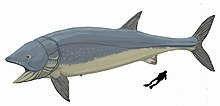Pachycormidae
| Pachycormidae | ||||||||||||
|---|---|---|---|---|---|---|---|---|---|---|---|---|

Life picture of Protosphyraena perniciosa |
||||||||||||
| Temporal occurrence | ||||||||||||
| Middle Jurassic to Upper Cretaceous | ||||||||||||
| 175.6 to 65.5 million years | ||||||||||||
| Locations | ||||||||||||
|
||||||||||||
| Systematics | ||||||||||||
|
||||||||||||
| Scientific name of the order | ||||||||||||
| Pachycormiformes | ||||||||||||
| Berg , 1940 | ||||||||||||
| Scientific name of the family | ||||||||||||
| Pachycormidae | ||||||||||||
| Woodward , 1885 |
The Pachycormidae are an extinct family of marine bony fish (Osteichthyes). They stand alone in the order Pachycormiformes and lived from the Middle Jurassic to the Upper Cretaceous .
features
Most of the genera of the Pachycormidae were tuna - or swordfish- like predatory fish that caught their prey in fast chases. They had long, scythe-like pectoral fins , the pelvic fins were only small or missing entirely. The caudal fin is homocerk and the caudal fin skeleton corresponds to that of the real bony fish (Teleostei). Most genera had a more or less extended rostrum . This feature was most clearly pronounced in Protosphyraena perniciosa from the Cretaceous period.
Within the Pachycormidae there is a monophyletic clade consisting of five genera , large marine, filtering plankton eater. Over a period of 100 million years in the Upper Mesozoic, the group assumed the ecological role that is occupied today by the baleen whales and some plankton-eating cartilaginous fish. This group includes the two meter long reach genres Astenocormus and Martillichthys , five meters long expectant Bonnerichthys and leedsichthys that is with a length of nine meters, the largest bony fish of all time.
Systematics
The Pachycormidae were initially classified as bone organoids (Holostei), a taxon that is now considered paraphyletic and is no longer common in modern systematics. Joseph S. Nelson classified them as very highly developed Neuflosser (Neopterygii) very similar to the real bony fish (Teleostei) . In a publication from January 2010 they are finally assigned to the Teleostei.
Genera
- Eugnathides
- Euthynotus Wagner, 1860
- Hypsocormus Wagner, 1860
- Orthocormus Weitzel, 1930
- Pachycormus Agassiz, 1833
- Prosauropsis
- Protosphyraena Leidy, 1857
- Sauropsis Agassiz, 1832
- Saurostom Agassiz, 1833
- Clade of marine plankton eaters
- Astenocormus Woodward, 1895
- Bonnerichthys Friedman et al. , 2010
- Leedsichthys Woodward, 1889
- Martillichthys
- Rhinconichthys Friedman et al., 2010
die out
The Pachycormidae, including the large marine plankton eaters, died out at the end of the Cretaceous-Tertiary border along with dinosaurs , pterosaurs and the large marine reptiles. The ecological niche of large be filtered plankton feeders initially remained unoccupied, then from the late Paleocene of manta rays and whale sharks , since the Middle Eocene of basking sharks and the Eocene Oligocene of the limit baleen whales taken. Only the basking mouth sharks , also marine, filtering plankton-eater, whose ancestors can be safely traced back to the Oligocene- Miocene border, could have been contemporaries of the Pachycormidae, as suggested by some fossil teeth from the early Upper Cretaceous. The only large, recent bony fish, which is also a filtering plankton eater, is the spoonbill , which lives in the fresh waters of North America and, with its elongated rostrum, reaches a length of two meters.
literature
- Joseph S. Nelson : Fishes of the World. John Wiley & Sons, 2006, ISBN 0-471-25031-7 .
- Robert L. Carroll: Paleontology and Evolution of the Vertebrates. Thieme, Stuttgart 1993, ISBN 3-13-774401-6 .
- Karl Albert Frickhinger: Fossils Atlas Fishes. Mergus-Verlag, Melle 1999, ISBN 3-88244-018-X .
Individual evidence
- ↑ a b c Friedman et al .: 100-Million-Year Dynasty of Giant Planktivorous Bony Fishes in the Mesozoic Seas. Science , 2010; 327 (5968): 990 doi: 10.1126 / science.1184743
- ^ Arno Hermann Müller: Textbook of Palaeozoology. Volume III, Vertebrates, Part 1. Gustav Fischer Verlag, 1985
- ↑ M. Friedman, K. Shimada, LD Martin, MJ Everhart, J. Liston, A. Maltese, M. Triebold: 100-Million-Year Dynasty of Giant Planktivorous Bony Fishes in the Mesozoic Seas . In: Science . tape 327 , no. 5968 , February 19, 2010, p. 990-993 , doi : 10.1126 / science.1184743 .
Web links
- Mikko's Phylogeny Archive Pachycormiformes

